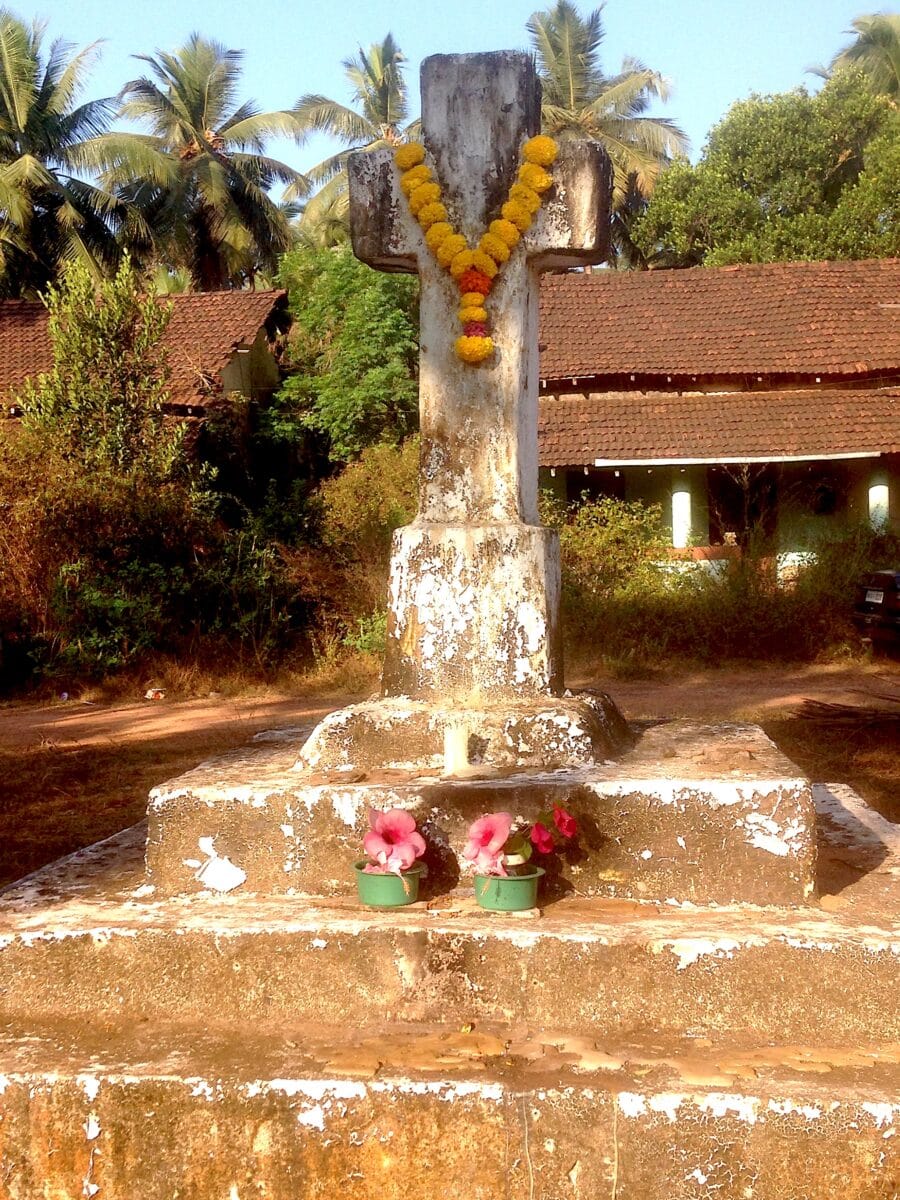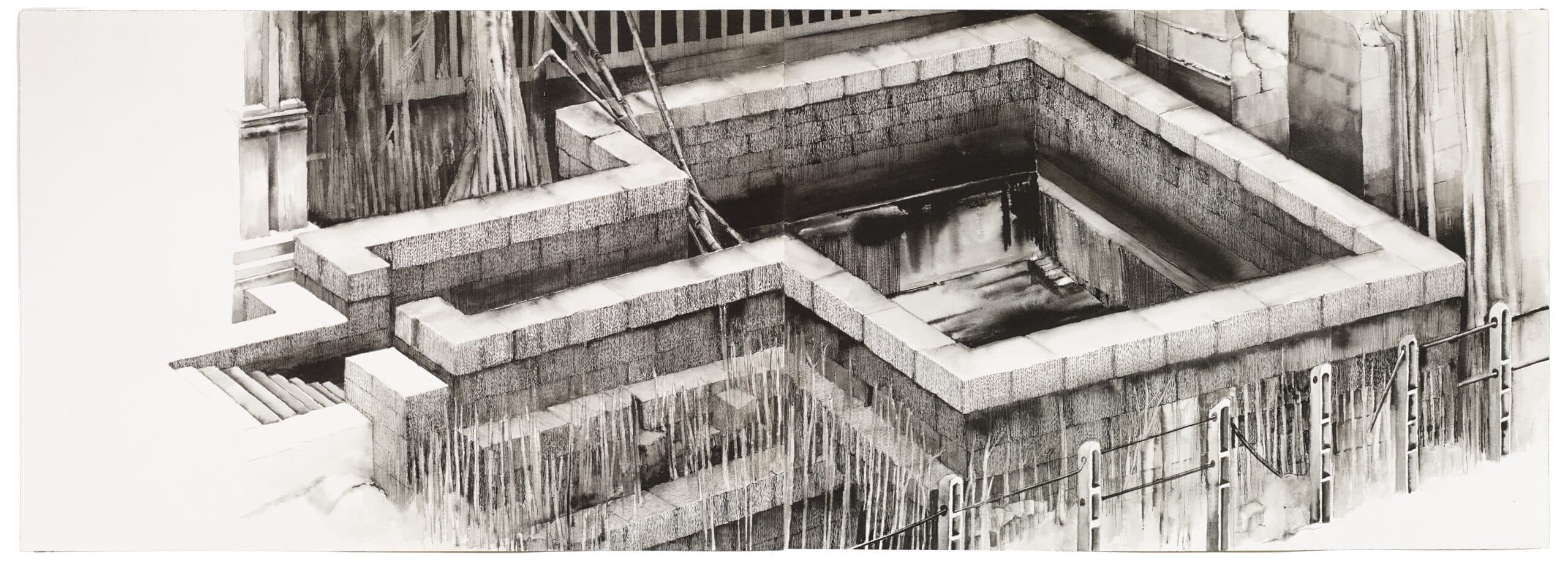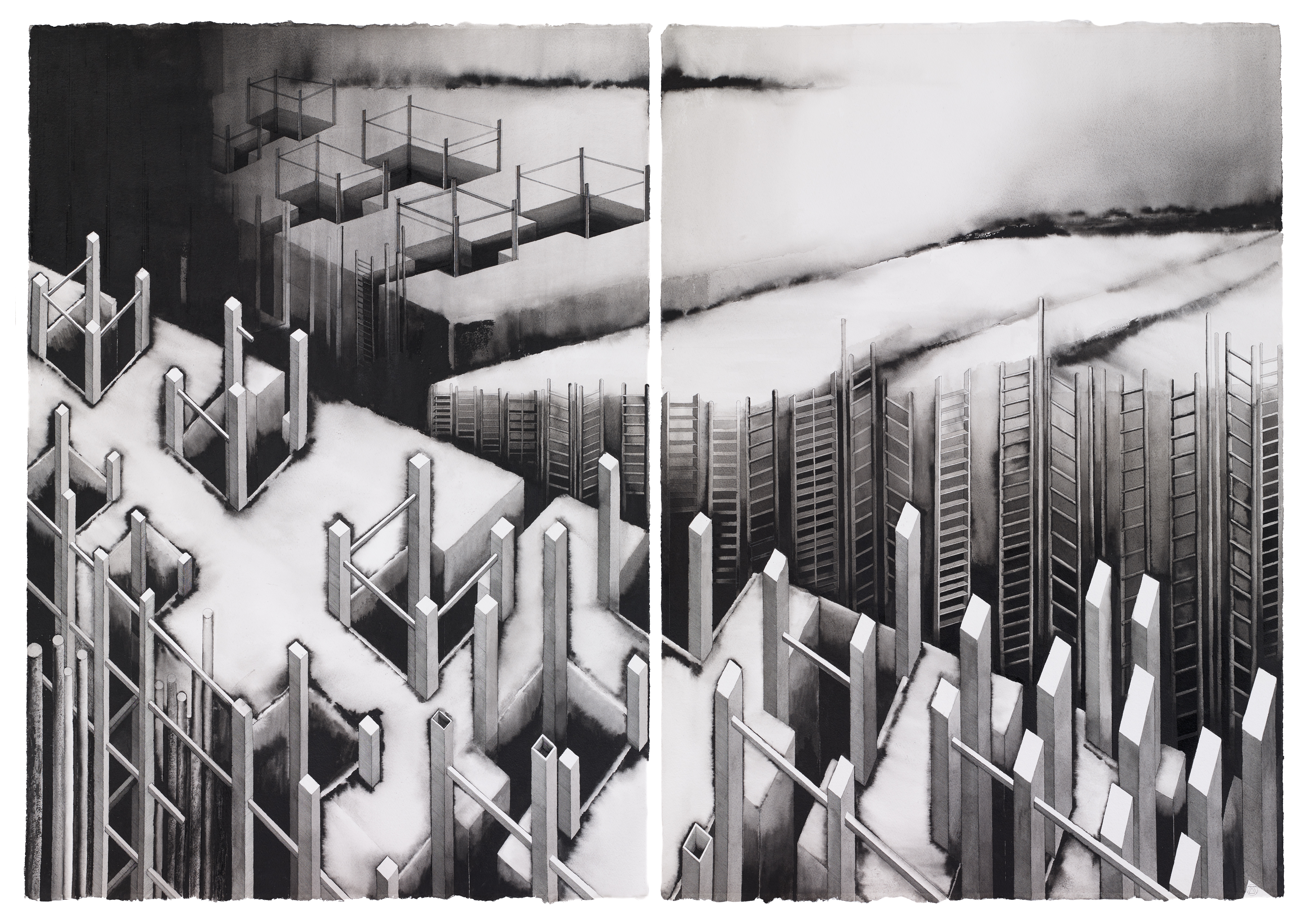In Defence of Metaphor
This text concludes Deanna Petherbridge’s series Drawing as Metaphor. The complete series will appear as a printed publication in the new year, designed by Studio Christopher Victor; the drawings will be on show at the Art Space Gallery (84 St Peter’s Street, London N1 8JS) in an exhibition titled Deanna Petherbridge: Drawing and the Domain of Politics (25 February – 25 March 2022).

The drawing Incidents in a traumatised landscape was completed sometime in early August, underpinned by my urge to pictorialise the events and perfidies of the political domain as a dysfunctional but interconnected landscape marked by trauma. It was only when I was well into completing the two panels that I realised that the curious hollow geometries of the stepped, empty and eroded land-works that made up this disjointed topography were heavily influenced by a stepped well that I had drawn in Goa in January 2020. It was made during a blissful stay in the beautiful house and exotic garden of novelist and psychoanalyst Sudhir Kakar and his wife, the writer and artist, Katharina Poggendorf-Kakar.
The small broken tank that I visited most mornings on a hot walk in the sea-sandy neighbourhood was abandoned, empty of water and overgrown with dried reeds, prickly stalks and ominous rustles that hinted at snakes. To approach it I had to bypass any number of hysterically barking dogs and step aside from the riotous lines of hogs and piglets following their morning forage train through sunken under-paths and wild dashes across tarmacked roads. It was near to a shabby little concrete shrine of a sometimes garlanded cross, but the shape and construction of the abandoned tank indicated that its disrepair might be related to its original contiguity to a now-disappeared temple, collapsed or deliberately destroyed many years ago. When I enquired about this, however, I heard all sides of a passionate debate about religion, ownership and nationalism.

I never photographed the actual tank or sketched it on the spot but would return to my borrowed studio to trace a regular keyhole form through a leisurely pen and ink re-construction of immaculately cut and regularly pitted laterite blocks, tilted to allow an indication of depth. None of the surrounding structures of my small two-panelled drawing were actually there: this was an act of invented graphic historicism and archaeology.

In retrospect, I believe that my interest in this small, neglected, dysfunctional – but still elegant – structure was deepened by my reflections on how it opened itself to the blame rhetorics of rampant Hindu nationalism. It reverberated both formally as satisfying architectonics and was embedded in any number of overlaid narratives that challenged its built neutrality. As a politicised historical object, it prompted the seemingly unconscious dynamic of appropriation and adaptation into the metaphorical layering of my later drawing Incidents in a traumatised landscape.

The View from Hotel Pandemia was drawn well into the first UK Covid lockdown of 2020 and followed on from Crossing the Abyss, employing similar elements of decaying wooden slats and disintegrating structures. It was a response to a description by a friend and colleague in Puerto Rico, the architect and photographer Ivonne María Marcial Vega, about the effect of the pandemic on the islanders, rich and poor, who were still suffering from the trauma of the hurricane disasters of 2017, subsequent earthquakes and their sense of abandonment by the USA. Her descriptions of the profound insecurity invading every aspect of life, including the very solidity of the ground beneath, led me to envision a fissured landscape where the distinctions between man-made structures and geological formations have somehow ruptured and fused into a barren fundament. Nothing is solid, all is in flux. Anxiety prevails.
This is the last of my series of essays, and so it is timely to admit that the organising theme stems from the seminal first chapter of a book project that I had been contemplating for some time. Entitled Drawing as Visual Metaphor, it proposed to examine the transformative properties of contemporary drawing from simple and private sketches to elaborate wall, book or moving images as a means of investigating the potency of analogue – by which I meant the symbolic tropes, metaphors and metonyms arising out of ‘analogy’ rather than deliberate representation. In this reading, the coded and abstract means of drawing process (lines, traces, vectors and other formal dynamics) are mapped over the underlying artistic engagement with concept and subject-matter in a manner comparable to the enrichment through defamiliarisation of metaphorical speech and text. My mistake was to insist in my proposal that this approach involved ‘contrasting the potentiality of originally generated and fresh graphic propositions with the stasis and literalness of ready-made imagery and the recycling of found material and concepts that dominate contemporary laissez-faire visual production.’ The fear that my argument was contingent on a critique of the tenacity of the Duchampian legacy immediately ruled the book out of court (note appropriate metaphor) for would-be publishers.
I first aired some of my ideas in a Zoom talk presented by the Warburg Institute in February 2021, citing a classic definition from Metaphors We Live By:
The essence of metaphor is understanding and experiencing one kind of thing in terms of another… metaphor is not merely a matter of language. It is a matter of conceptual structure. And conceptual structure is not merely a matter of the intellect – it involves all the natural dimensions of our experience, including aspects of our sense experiences: colour, shape, texture, sound, etc. These dimensions structure … aesthetic experience as well. [1]
Now, after writing seven essays about my own recent drawings in relation to other relevant texts and works, I had planned to finish by re-examining the theories of embodied metaphor, only to discover again that most of the contemporary work in this enormous literary domain is in the empirical area of corpus linguistics. A wonderfully suggestive publication about ‘the communicative possibilities and effects of visual metaphor in multimodal discourse’, Visual metaphor: structure and process, edited by Gerard J. Steen, for example, promises in its blurb:
Metaphor has recently been reconceptualised as a fundamental part of the human conceptual system… expressed in language but also in other modalities and media of communication, including gesture and body language, sound and music, and film and visuals. In spite of this theoretical landslide, however, the wide range of nonverbal metaphor and its processing has neither been empirically investigated on the same scale nor with the same rigour as metaphor in language. The overarching goal of this book is to report on the findings of a research program aimed at exploiting the vast cognitive linguistic and psycholinguistic expertise on metaphor in language for a new, behaviourally founded approach to the structure and processes of metaphor in one of these nonverbal manifestations, namely static visuals. [2]
In avoiding a systematically ordered avalanche of visual puns in cartoons and advertisements and their interpreted meanings, I turned instead, this November, to Mieke Bal’s Of what one cannot speak: Doris Salcedo’s Political Art in the hopes of illumination on the processes of visual metaphor and the efficacy of political art in relation to the Colombian artist’s powerful and memorable sculptures and installations. [3] Cultural critic Mieke Bal, who declared her philosophical stance on authorial ‘intentionality’ in an earlier publication (and in relation to which I take a very different view about artistic agency) resolutely flags up in the introduction that she is ‘not even interested in what artists themselves say about their art’ with a note that it is ‘the task of the critic to establish connections between art as it functions in the public domain and its viewers.’ [4] She accordingly approaches Salcedo’s projects as ‘theoretical objects’ or ‘the case’, but not, mysteriously, as an unqualified ‘case study’. ‘Salcedo’s work is singular but not particular’, she declares, basing her usage on that of George Didi-Huberman’s ‘What is irreducible and hence, carries strangeness is singular’ and with further reference to Alain Badiou. [5] I was much taken with this complex set of propositions, but it soon becomes apparent that they bore little relationship to my own airing of ‘unitary’ art practice as suggested in my penultimate essay Architectonic Landscapes.
The title of Bal’s book Of what one cannot speak directly relates Salcedo’s project to Theodor Adorno’s indictment of ‘art after Auschwitz’ and also to Ludwig Wittgenstein’s last sentence of the Tractatus Logico-Philosophicus: ‘Whereof one cannot speak, thereof one must be silent.’ In Salcedo’s oeuvre, the implications of buried bodies suggested through clothes and fabrics embedded in furniture pieces in versions of La Casa Viuda (1992–1995 and 1998); the timed appearance over 53 hours of 280 chairs fixed to the high facade of the Palace of Justice in Bogotá in the installation Noviembre 6 y 7 (2002) in memory of mass killings and the violent seizing of the Supreme Court of 6 and 7 November 1985; or the huge crack in the floor of the Turbine Hall, Tate London, Shibboleth (2007) are ‘anchored in real, material trace of past life, of past suffering’ and this bleak ‘aesthetics of anthropomorphism as politics’ functions metonymically. [6] Later Bal suggests that the works are
both time-specific and time-dependent, in terms of the works themselves, the past they carry, and their relationship to the viewer. They are bound to specific events in the past that the artist has painstakingly researched but does not recount. … temporally, she gives them… a foreshortened duration. [7]
When, for the Eighth International Istanbul Biennale Salcedo filled an empty space between two buildings with an amazing installation of 1,550 chairs, Bal interprets this as an act of translation, ‘of the possibility of migrating to other places without losing the singularity that informs the work and constitutes its political thrust as a trace.’ ‘This is how installation – the temporary occupancy of a space within which the spectator is implicated – can constitute an act of memory for others.’ ‘This appeal to perform acts of memory does not serve an idealistic purpose such as redemption.’ [8] Salcedo herself is often quoted as calling this project a ‘topography of war’ not a specific historical event. [9] Well after the publication of Bal’s book, Salcedo created Sumando Ausencias (Adding absences) (2016) together with a group of volunteers, who for five days sewed together pieces of white cloths with the names of victims of Colombian conflict in Bolívar Square, Bogotá. In an interview in 2008, Salcedo stressed the collaborative aspect of her work:
I have focused all my work on political violence, on forceful displacement, on war… but not on the large event. I focus on the small, individual, particular experience of a human being… The memories of anonymous victims are always being obliterated. I’m trying to rescue that memory. [10]
As an artist working solely in the medium of drawing, I have never had my work legitimised by a major art theoretician, nor been faced with the no doubt distracting insertion of another’s formidably argued thesis into the aporia of my own thinking and practice. I end with some notes about my last finished drawing of 2021, Shafted. The simple punning title refers to the slang metaphor for swindling and the drawing presents fenced and regimented mineshafts boring into bare sloping plains in gathering darkness. Ladders lead out of ominous ravines between the plains but do not give access or exit to the sunken shafts. Stepped ladders are straightforward symbols of upward aspiration: think of the sculpted Jacob’s ladders on the facade of Bath Abbey, only wide enough for a single angel to climb. They point the way for escape in this drawing, while the downward shafts are about entrapment and victimisation of the many.

Over the years, others have suggested that my drawings invite positive as well as negative constructions. Visual metaphors are always open to ambivalent readings, so I leave all interpretations to you.
Notes
- George Lakoff and Mark Johnson, Metaphors We Live By (Chicago and London: University of Chicago Press, 2003), p. 5.
- Visual metaphor: structure and process, ed. by Gerard J. Steen (Amsterdam and Philadelphia: John Benjamins Publishing Company, 2018).
- Mieke Bal, Of what one cannot speak: Doris Salcedo’s Political Art (Chicago and London: University of Chicago Press, 2010).
- Of what one cannot speak, p. 2 and footnote 1, p. 3 where she cites chapter 7 of Mieke Bal, Travelling Concepts in the Humanities: A Rough Guide (Toronto: University of Toronto Press, 2002).
- ibid, footnote 7, p. 7 and footnote 10, p. 11. She further elaborates the ‘careful preservation of singularity’ through the activity of ‘metaphoring’ on p. 33.
- ibid., pp. 18 & 19.
- ibid., p. 152.
- ibid., pp. 218, 220, 221.
- Michelle Aldredge, ‘Artist Doris Salcedo: I Began to Conceive of Works Based on Nothing,’ Gwarlingo (2012). https://gwarlingo.com/2012/artist-doris-salcedo-i-began-to-conceive-of-works-based-on-nothing/. [Accessed 22 November 2021].
- Doris Salcedo interviewed by Susan Sollins, ‘Variations on Brutality’, Art21 (April 2013). https://art21.org/read/doris-salcedo-variations-on-brutality/. [Accessed 23 November 2021].

– Deanna Petherbridge